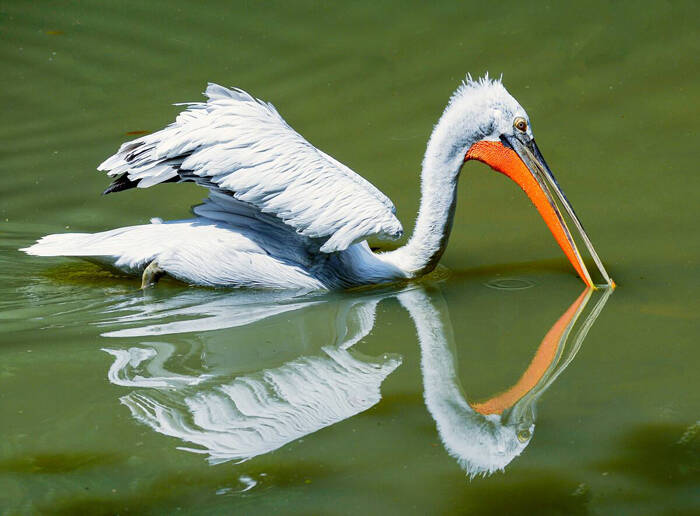Pelecanus crispus
IUCN
LCBasic Information
Scientific classification
- name:Pelecanus crispus
- Scientific Name:Pelecanus crispus,Dalmatian Pelican
- Outline:Waterfowl
- Family:pelican G.pelican
Vital signs
- length:160-180cm
- Weight:10-15kg
- lifetime:About 30-40 years
Feature
The neck is often bent into an "S" shape and tucked into the shoulders
Distribution and Habitat
Distributed in southeastern Europe, northern Africa and eastern Asia. Including Afghanistan, Albania, Armenia, Azerbaijan, Bulgaria, China, Egypt, Georgia, Greece, Hong Kong, India, Islamic Republic of Iran, Iraq, Israel, Kazakhstan, Kyrgyzstan, Lebanon, Moldova, Mongolia, Montenegro, Pakistan, Romania, Syrian Arab Republic, Tajikistan, Turkey, Turkmenistan, Ukraine, Uzbekistan.
Possibly extinct: Bangladesh. Regionally extinct: Bosnia and Herzegovina, Croatia, Germany, Macedonia.
Migrant bird: Algeria, Cyprus, Czech Republic, Italy, Japan, South Korea, Kuwait, Latvia, Norway, Oman, Poland, Slovakia, Spain, Taiwan Province of China, United Arab Emirates, Western Sahara.
Origin uncertain: Serbia, Sri Lanka.
Found in the north of China, migrates to the south in winter, and a small number of individuals regularly overwinter in Hong Kong. Produced in Xinjiang, Qinghai and coastal areas south of Shandong. [3] In 2022, sub-adult Dalmatian pelicans were found in the Golden Coast Na
Appearance
The beak is lead-gray, long and thick, with the back half of the upper and lower beak edges yellow, and a yellow claw-like hook at the front. The whole body is grayish white. The crest feathers on the head are curled, and the feathers on the nape are extended and curled. The exposed skin on the cheeks and around the eyes is creamy yellow or flesh-colored. In summer, the waist and undertail coverts are slightly pink. The beak is wide, straight, long and pointed, lead-gray, with the back half of the upper and lower beak edges yellow, and a yellow claw-like hook at the front. There is a large orange-yellow or light yellow leather bag on the lower jaw that is the same length as the beak and can be retracted. The body feathers are mainly silver-white with gray. The flight feathers are black with white feather edges. The crest feathers on the head are curled. The exposed skin on the cheeks and around the eyes is creamy yellow or flesh-colored. The neck is long. The wings are wide. The tail f
Details
The Dalmatian Pelican, whose foreign name is Dalmatian Pelican, is a large white waterbird with no subspecies.

Curly-feathered pelicans like to live in groups. The sound is low and hoarse. It likes to live in groups and swim, but it cannot dive and is good at walking on land. The neck is often bent into an "S" shape and tucked into the shoulders. Curly pelicans migrate short distances. They fly gracefully, raising their necks like herons, and the whole group flies together.
Curly pelicans migrate in March and the breeding season is from April to June every year. Nests in trees near water. Each clutch lays 3-4 eggs, which are light blue or slightly green. The parent birds take turns incubating the eggs. Incubation usually takes 30-32 days. Both sexes incubate the eggs and feed the chicks. The baby pelicans that have just hatched from their eggshells are gray-black in color, and will soon be covered with light white down. The parent bird feeds the chicks half-digested fish meat. When the chicks grow up, they put their heads into the skin of the parent bird's open mouth and peck at the small fish brought back. The parents first throw their food in the nest. Young pelicans can take flight at 12 weeks and are independent by 14-15 weeks.
The curly-feathered pelican is listed as "vulnerable" on the International Union for Conservation of Nature's Critical List of Threatened Species, and its population is declining year by year. It is estimated that the global population of curly pelicans is around 10,000 to 20,000, of which there are 4,000 to 5,000 pairs. Curly pelicans breed in wetland areas, and their habitats are widely dispersed, from eastern and southeastern Europe to Mongolia and coastal China and Hong Kong.
Wetland depletion and fishermen hunting were the main reasons for the decline in curly pelican numbers. They also face other threats, including disturbance from tourists and fishermen, destruction and modification of wetland habitats, water pollution, collision with overhead power lines, and overfishing.
Listed in the "World Conservation Union Red List of Threatened Species" (IUCN) ver3.1: Near Threatened (NT)
It is included in the first level of China's "List of National Key Protected Wild Animals" (February 5, 2021).
Protect wild animals and eliminate wild game.
Maintaining ecological balance is everyone’s responsibility!








